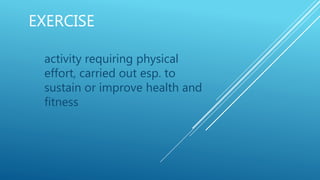
7 Principles of Exercise
- 1. EXERCISE activity requiring physical effort, carried out esp. to sustain or improve health and fitness
- 2. PRINCIPLES OF EXERCISE There are 7 principles of exercise Individuality Specificity Progression Overload Adaptation Recovery Reversibility
- 3. INDIVIDUALITY Everyone is different and responds differently to training. Some people are able to handle higher volumes of training while others may respond better to higher intensities. This is based on a combination of factors like genetic ability, predominance of muscle fiber types, other factors in your life, chronological or athletic age, and mental state.
- 4. SPECIFICITY Improving your ability in a sport is very specific. If you want to be a great pitcher, running laps will help your overall conditioning but won’t develop your skills at throwing or the power and muscular endurance required to throw a fastball fifty times in a game. Swimming will help improve your aerobic endurance but won’t develop tissue resiliency and muscular endurance for your running legs
- 5. PROGRESSION To reach the roof of your ability, you have to climb the first flight of stairs before you can exit the 20th floor and stare out over the landscape. You can view this from both a technical skills standpoint as well as from an effort/distance standpoint. In order to swim the 500 freestyle, you need to be able to maintain your body position and breathing pattern well enough to complete the distance. In order to swim the 500 freestyle, you also need to build your muscular endurance well enough to repeat the necessary motions enough times to finish.
- 6. OVERLOAD To increase strength and endurance, you need to add new resistance or time/intensity to your efforts. This principle works in concert with progression. To run a 10-kilometer race, athletes need to build up distance over repeated sessions in a reasonable manner in order to improve muscle adaptation as well as improve soft tissue strength/resiliency. Any demanding exercise attempted too soon risks injury. The same principle holds true for strength and power exercises.
- 7. ADAPTATION Over time the body becomes accustomed to exercising at a given level. This adaptation results in improved efficiency, less effort and less muscle breakdown at that level. That is why the first time you ran two miles you were sore after, but now it’s just a warm up for your main workout. This is why you need to change the stimulus via higher intensity or longer duration in order to continue improvements. The same holds true for adapting to lesser amounts of exercise
- 8. RECOVERY The body cannot repair itself without rest and time to recover. Both short periods like hours between multiple sessions in a day and longer periods like days or weeks to recover from a long season are necessary to ensure your body does not suffer from exhaustion or overuse injuries. Motivated athletes often neglect this. At the basic level, the more you train the more sleep your body needs, despite the adaptations you have made to said training.
- 9. REVERSIBILITY If you discontinue application of a particular exercise like running five miles or bench pressing 150 pounds 10 times, you will lose the ability to successfully complete that exercise. Your muscles will atrophy and the cellular adaptations like increased capillaries (blood flow to the muscles) and mitochondria density will reverse. You can slow this rate of loss substantially by conducting a maintenance/reduced program of training during periods where life gets in the way, and is why just about all sports coaches ask their athletes to stay active in the offseason.
- 11. A well balanced exercise program needs to include three major areas of fitness: Resistance or strength training, aerobic or cardio training and stretching or flexibility training. Resistance (strength) training 20 minutes of resistance training with dumbells, barbells, body weight, resistance bands or using weight machines twice a week. All the major muscle groups of the legs, abdomen, arms, chest, back and shoulders should be worked.
- 12. Aerobic (cardio) training 30 minutes of exercise at about 60% to 85% of your maximum heart should be done at least 3 times per week, more often is best. The 60% to 85% is known as your the aerobic range, which is calculated by subtracting your age from 220, then multiplying that number by .60 and .85 to obtain your heart rate range.
- 13. Stretching (flexibility) training 15 minutes of stretching, after you’re fully warmed up, to include all the major muscle groups at least 3 times per week.
- 15. ISOTONIC EXERCISE This type of exercise is also called dynamic or cardiovascular exercise, and it describes the kind of activities where you move the joints and muscles in your arms or legs. This is usually the best kind of exercise for people with a heart condition, but you need to check with your specialist before you do it for the first time. Isotonic exercise includes leisurely walking swimming cycling walking fast dancing skipping
- 16. ISOMETRIC EXERCISE This type of exercise is also called static, weight or resistance exercise. It doesn’t involve very much joint movement as it is mostly muscle work. Often people with heart conditions need to avoid some of these exercises because they put a strain on your heart and blood vessels. Check with your specialist before you join a gym or start doing any of these. Isometric exercise includes weight-lifting athletic throwing events some gym equipment rock-climbing boxing, wrestling martial arts